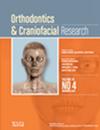Predicting the Risk of Maxillary Canine Impaction Based on Maxillary Measurements Using Supervised Machine Learning
Abstract
Objectives
To predict palatally impacted maxillary canines based on maxilla measurements through supervised machine learning techniques.
Materials and Methods
The maxilla images from 138 patients were analysed to investigate intermolar width, interpremolar width, interpterygoid width, maxillary length, maxillary width, nasal cavity width and nostril width, obtained through cone beam computed tomography scans. The predictive models were built using the following machine learning algorithms: Adaboost Classifier, Decision Tree, Gradient Boosting Classifier, K-Nearest Neighbours (KNN), Logistic Regression, Multilayer Perceptron Classifier (MLP), Random Forest Classifier and Support Vector Machine (SVM). A 5-fold cross-validation approach was employed to validate each model. Metrics such as area under the curve (AUC), accuracy, recall, precision and F1 Score were calculated for each model, and ROC curves were constructed.
Results
The predictive model included four variables (two dental and two skeletal measurements). The interpterygoid width and nostril width showed the largest effect sizes. The Gradient Boosting Classifier algorithm exhibited the best metrics, with AUC values ranging from 0.91 [CI95% = 0.74–0.98] for test data to 0.89 [CI95% = 0.86–0.94] for crossvalidation. The nostril width variable demonstrated the highest importance across all tested algorithms.
Conclusion
The use of maxillary measurements, through supervised machine learning techniques, is a promising method for predicting palatally impacted maxillary canines. Among the models evaluated, both the Gradient Boosting Classifier and the Random Forest Classifier demonstrated the best performance metrics, with accuracy and AUC values exceeding 0.8, indicating strong predictive capability.

 求助内容:
求助内容: 应助结果提醒方式:
应助结果提醒方式:


